24 March 2008

This illustration depicts a cross-section of Saturn’s largest moon, Titan. Cassini scientists speculate there may be a layer of liquid water mixed with ammonia about 100 km below the surface of Titan.
Credit: NASA/JPL
NASA's Cassini spacecraft has discovered evidence for an ocean of water and ammonia beneath the crust of Saturn's largest moon, Titan. The discovery was made using radar measurements of Titan's rotation.
"With its organic dunes, lakes, channels and mountains, Titan has one of the most varied, active and Earth-like surfaces in the Solar System," said Ralph Lorenz, a Cassini scientist and principal author of the research article that details the discovery. "Now we see changes in the way Titan rotates, giving us a window into Titan's interior beneath the surface."
A team of scientists applied Cassini's Synthetic Aperture Radar to obtain imaging data during 19 flybys of Titan between October 2005 and May 2007. The radar can peer through Titan's dense, methane-rich hazy atmosphere, recording features and determining their locations on the moon's surface.
The early radar observations enabled the scientists and radar engineers to establish the locations of 50 intriguing surface features on Titan. The researchers then searched for these same lakes, canyons and mountains in the wealth of data relayed by Cassini during its later flybys of Titan.
They discovered that remarkable surface features had been displaced from their expected positions by up to 30 km. A systematic shift of landmarks would be difficult to explain unless Titan's icy crust was decoupled from its core by an internal ocean, leading to the crustal motion.
"We believe that about 100 km beneath the ice and organic-rich surface is an internal ocean of liquid water mixed with ammonia," said Bryan Stiles of NASA's Jet Propulsion Laboratory (JPL). Stiles is one of the authors of the paper.
The study of Titan is a prime objective of the Cassini-Huygens mission because it may preserve, in very low temperatures, many of the chemical compounds that preceded life on Earth. Titan is the only moon in the solar system that possesses a dense atmosphere. The moon's atmospheric pressure is 1.5 times that of Earth's. Titan (5,150 km across) is larger than the planet Mercury (4,880 km across).
A new Cassini flyby of Titan is due, on March 25 2008. Just prior to its closest approach at an altitude of 1,000 km, Cassini will employ its Ion and Neutral Mass Spectrometer to observe Titan's upper atmosphere.
Further Reading
JPL News Release
http://www.jpl.nasa.gov/news/news.cfm?release=2008-048
NASA’s Cassini Websites
http://www.nasa.gov/mission_pages/cassini/main/index.html
http://saturn.jpl.nasa.gov/home/index.cfm
Aymen Mohamed Ibrahem
Senior Astronomy Specialist